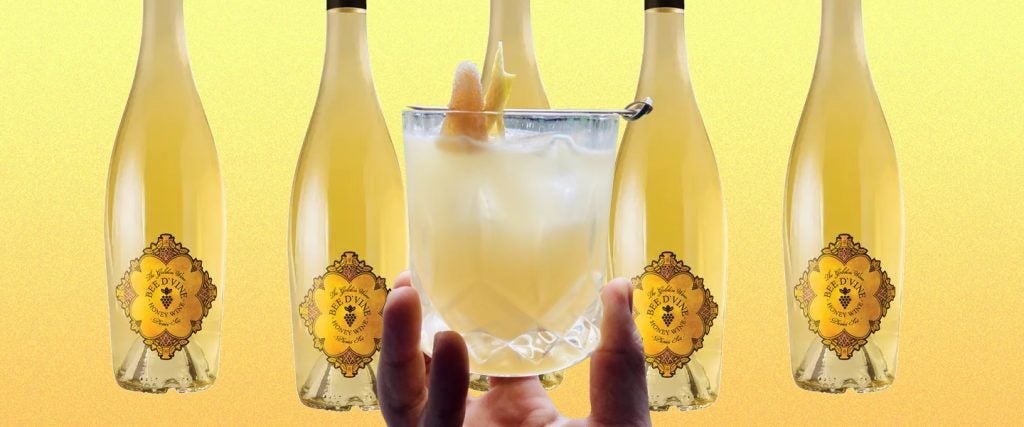For the last several years, I’ve been showing up at holiday gatherings with a perfunctory bottle of champagne or red wine, figuring that these old classics are the best, most versatile way to accompany winter meals and festivities. And perhaps they’re classic for good reason — but amid the doldrums of the Omicron Holidays®, let me suggest a bottle of something that will spark some curiosity, and likely debate, at the table with chosen friends and family: Mead.
Mead is one of many cultural names for honey wine, which is made by allowing honey and water to ferment with yeast, creating an alcoholic beverage akin to grape wine, but very distinct in flavor. It can come in both still and bubbly form, and there are more varieties available in the American market than ever before, thanks to a nascent but significant boom in honey-wine consumption across the country.
Anywhere across the country, if there are bees, there is likely honey wine. I first tasted honey wine at my favorite Ethiopian restaurant, where it was called t’ej. It’s a traditional beverage in various forms across Latin America, including in Mexico’s Yucatan region, where they produce an anise-flavored honey wine called xtabentún.
There’s evidence honey wine was brewed some 4,000 years ago in Babylon, and even longer ago in ancient China and India. Then there’s the Celtic tradition, which legend says is the origin of the term “honey-moon” — because the wedded couple is to drink mead for a full moon cycle after the ceremony, taking advantage of its aphrodisiac effects.
Regardless of its exact origins, mead is perhaps the oldest form of booze made by man: An alchemy of nature, curiosity and coincidence, made possible by the effect airborne yeast has on sugar. The fact that it’s such a niche beverage in 2021 seems almost strange, given its legacy — why did mead ever fall out of fashion, anyway? Likely because of growing availability of cane sugar, plus the rise of mass production of beer and grape wine — all of which created novel alternatives to mead, without the hassle of fighting off angry bees.
“Mead seemed to fall when spirits became more widely available, so we’re looking at a time between the 1700s and 1800s. Mead is hard to make, especially in the 1700s when you lacked the equipment to obtain honey,” Fred Minnick, author of Mead: The Libations, Legends and Lore of History’s Oldest Drink, told Vogue.
Although the mead boom has picked up in the last five years, I’ve remained naive to the possibilities of the drink at home and the holiday table. Following a recommendation from a friend, I picked up a bottle of Bee D’Vine by the Honey Wine Company from my local corner store, hoping for the best.
Mead can come in a range of sweetness levels, but I opted for the dry “Brut” style, and it didn’t disappoint. The aroma is all honey and earth, but the flavor is crisp and fruity, akin to a sauvignon blanc. The finish reminded me of dry vermouth, with a mellow nuttiness that lingers on the tongue. It tasted a lot like, in simple terms, a funky-ass white wine.
Fitting, then, that Bee D’Vine is made in Northern California’s Sonoma County, a golden expanse largely dominated by wine grapes. It’s made by Ayele Solomon, a conservationist who grew up sipping Ethiopian honey wine and was inspired to start his company to help bees and forests. And it makes you wonder: Considering that mead is less environmentally taxing than grape wine and can help save the dying bees, maybe we should be drinking a lot more of it.
That’s easy enough today thanks to a bevy of craft producers who are whipping up new styles of honey wine, including mead made with fruit juices to add a sharper, more acidic edge to the sweetness. But tasting a bottle of mead made me daydream about how the floral wine could be used in cocktails. Two options in particular stood out. Consider them my gifts to you this holiday season…
The Mead Martini
Ingredients
2 ounces dry gin
2 ounces mead
Instructions
Combine in a large glass, add in a generous amount of cubed ice and stir for 30 seconds using a bar spoon or chopstick. You want the ice to be spinning smoothly, not knocking around and making chips. Strain into a chilled martini glass and decorate with your choice of garnish (I prefer lemon peel for this cocktail).
Bee Penicillin
Ingredients
2 ounces blended Scotch whisky
2 ounces of mead
½ ounce lemon juice
½ ounce of honey simple syrup
A few slices of ginger
Lemon peel and candied ginger for garnish (optional)
Instructions
In the bottom of your favorite cocktail shaker, add the ginger, lemon juice and honey syrup and crush with a muddler. (For the honey syrup, just combine roughly equal parts honey and water, and blast it in the microwave until it’s melted.) Then add the mead and whisky, plus a handful of ice, and shake strongly for 15 seconds. Strain the drink into a rocks glass with fresh ice, then garnish with a piece of candied ginger and a neat piece of lemon peel, poked onto a toothpick.

